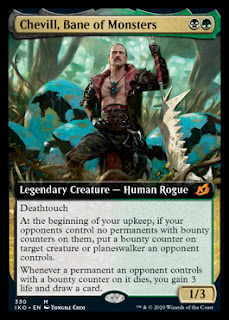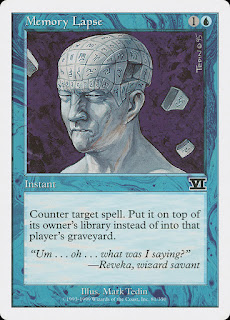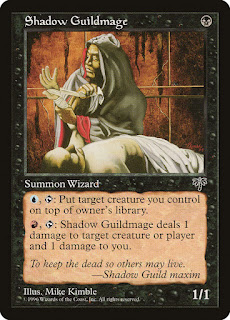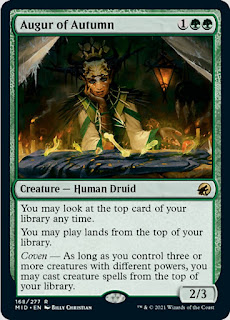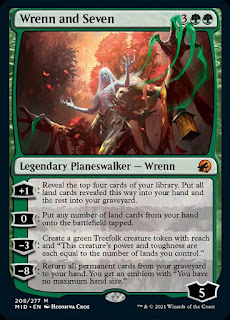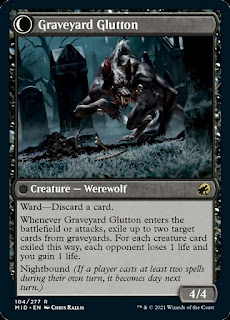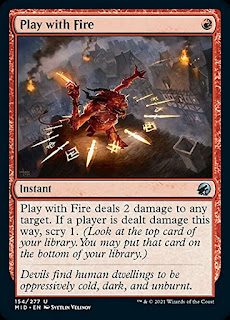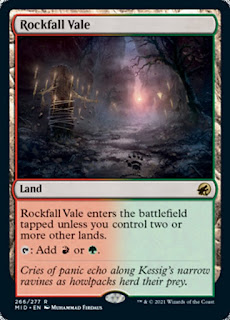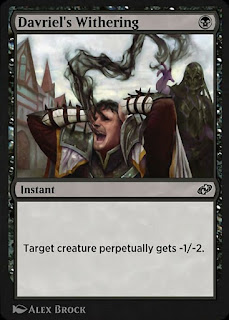We've got a few days until Midnight Hunt comes out so I asked folks to ship some questions for a Q and A post. If there's anything I like more than playing Magic, it's talking about Magic.
What's your favorite Mind Rot?
Great question. My friend Steve asked me to do a Top 10 Mind Rots post. I can tell you that my favorite Mind Rot is Blightning, but I don't think it's the best. I'm going to define Mind Rot as a sorcery that makes the opponent discard two cards.
10. Unburden - The best thing to do with a Mind Rot when you don't need a Mind Rot is to cycle it, but you'll probably just draw a different Mind Rot.
9. Carnival/Carnage - Carnage is not as good as Blightning because the new damage templating doesn't let you hit planeswalkers. However, I really liked this in Standard a couple years ago, when Llanowar Elves and cheap red, white, and blue one-drops were all over the place. You have no idea how many Teferis I picked off after they used their -3.
8. Heartless Pillage - Build your own Gerard's Verdict? Honestly does some good work as a sideboard card in decks where you have lots of two drop creatures. Two drop on two, attack and Pillage on three, then five mana Planeswalker on four is a nice plan when you're in an aggressive role.
7. Stupor - Pretty good.
6. Go Blank - One of the worst parts of Mind Rots is when they discard stuff but also have graveyard abilities to recover. Sure I'll just go discard this Arclight Phoenix or Kroxa or Unburial Rites or whatever, great card advantage spell. With Go Blank, no shenanigans allowed. Plus, it's a graveyard hate spell for Dredge or whatever, so it's a nice sideboard slot.
5. Inscription of Ruin - The best part here is that it's Mind Rot that can do other things. There are lots of times where Mind Rot is a good enough card to cast in a constructed game, but the times when it isn't, it really isn't, and so doing something else with the Inscription is a huge deal. Also, Mind Rot is obviously bad when your opponent has no cards and you've drawn it on turn twelve, but Inscription is great in that scenario.
4. Wrench Mind - The problem here is that if they happen to have an artifact, it's so bad. But two mana vs three is a huge deal.
3. Blightning - The crucial part here isn't that it domes the opponent for three, it's that it can do that if you want but also you can blow up an opposing planeswalker. Folks like to say that Bloodbraid Elf was the reason Jace the Mind Sculptor was kept in check in Standard, but Blightning was a big part of it.
2. Gerard's Verdict - If this cost 3 it would still be pretty high on this list, but at two mana it's so good. You either want to be gaining life or gaining card advantage in most matchups, and this card does it all. I think this is the one card that if it got ported to Modern would make me want to play either Abzan or a white splash.
1. Hymn to Tourach
Honorable Mention to Davriel, Rogue Shadowmage, who usually is a three mana discard two, but when you hit all three cards with him, it's awesome. Done a lot of work with Davriel in my day, I have.
No Way Out from the new Midnight Hunt seems interesting, but it's in the same Standard as Inscription and Go Blank. I could be wrong, maybe it's gas.
What's your favorite weird card you've played and why?
See, I don't think I play weird cards. All the cards I play are pretty basic. My idea of a weird card is something like The Ozolith or Hollow One, things that require you to do weird things. My weird cards are just weird because few people play them, not because they are strange.
Looking at that list of stuff, there's lots to choose from. There's a few reasons for that. One is that I've been playing for a long time, so I have a backlog of cards I remember for when a metagame calls for certain effects. Another is that players don't often know how to play against stuff if it's not the same things they always play against. And of course, I just like certain cards and have fun playing them.
I guess another thing is that I just don't really care what the status quo cards are. When I build every deck in Historic with Shivan Fire and Flunk in the sideboard while playing zero Heartless Acts and Fatal Pushes, I'm sure it looks strange, but I play them because it works. As long as you can be honest with yourself and not just play weird stuff for the sake of being different, then you should feel absolutely free to play what you want. It is entirely possible that you're right and everyone else is wrong.
A few that come to mind are Bitterblossom, Chevill, Wolfir Avenger, and Sprouting Thrinax. I think maybe my favorite though is Shadow Guildmage. It's not the case anymore, but a turn one Guildmage was close to unbeatable for a lot of decks in Modern around five years ago. Affinity, Infect, Humans, any of the Collected Company decks, all of them just fold to this thing. I beat a medium-fame SCG Grinder with it once and saw later they tweeted "Just got taught a lesson by Shadow Guildmage." But again, the trick with these cards is to only play them when they work. None of the decks Shadow Guildmage preys on see play these days, so my Guildmages are back on the shelf. But some day, when it's time again, get ready.
How do we feel about punishing Memory Lapse and Expressive Iteration? Is it possible that maindecking Cindervines is correct?
Lots going on here. First, I don't think that it's that outlandish to play maindeck Cindervines when both the metagame calls for it and it works in the deck you're playing. I'm not sure that right now meets the first criteria (I could be convinced otherwise) and as far as Jund Midrange goes, it certainly doesn't meet the second.
As far as a midrange card, Cindervines doesn't really do it for me. We don't put on enough life total pressure, or at least can't rely on putting on enough life total pressure, for the damage to matter that much. A lot of what makes Cindervines good is when your aggressive game plan forces your opponent to take damage when they don't want to because they don't have any other choice. Sometimes we get that draw, and you can tune your deck to get it more consistently if you want to, but lots of times we don't, letting the opponent dictate how much they want to let Cindervines affect the game. You can cast a Cindervines on turn two and have your opponent cast literally 19 spells and still lose that game.
I've put Cindervines in my sideboard before to fight Nexus of Fate decks, but that's just one particular metagame call. The most twisted I ever got in deck construction in Historic I think was when I jammed four main deck Massacre Wurms to fight against Field of the Dead. Field of the Dead decks were the most common and best decks in the format, and drawing a Massacre Wurm turned the matchup from legitimately unwinnable to legitimately unloseable, not to mention being the checkmark against Goblins and other creature decks. Desperate times call for desperate measures, but I'm not sure we're there.
These Jeskai decks are good, but they're plenty beatable, as are the Phoenix decks and the control decks. The three best decks in the format all being blue decks isn't actually that rare a phenomenon, if you go back in Magic's history far enough.
What got you so into Jund?
I've kind of wondered this myself for a while. I think that there's two things.
One is that I grew up and still live in Vermont. Well before Arena and even before Magic Online, Magic metagames and philosophies were very regional-based. Sure, we all had StarCityGames and other strategy sites, but nothing really teaches you Magic like learning from the player sitting next to you. In Vermont, our big defining player was Jamie Wakefield.
Wakefield is best known for playing green decks, but he also liked black midrange decks. He was kind of an innovator and definitely came up with his own philosophies and theories. I don't really remember it fully, but I think he came up with the concept of a creature that can attack being a source of card advantage, theoretically. Like, given enough turns, a Wild Nacatl is worth seven Lava Spikes. I still base a lot of my deckbuilding on that, I like creatures and threats that can win the game by themselves, hence the Cindervines stuff previously. Wakefield was actually on the cutting edge there, the only real creatures people played for like the first decade of Magic were Morphling and Jackal Pups, so casting a bunch of mid-sized creatures and winning the game was a big deal. He wasn't Patrick Chapin or Mike Flores or anything, but he was a big deal. Lots of the local players from the time when I started playing were disciples of Wakefield and I think it shaped a lot of how the more tenured players play. I don't think I ever played against or really interacted with Jamie, but he influenced a lot of the people who influenced me, like Aaron McCaslin and Jeremy Muir, and looking back you can tell that a lot of the Vermont Magic scene was shaped by him. And it really was a stark contrast from outside of the state. I have a lot of memories of grisly looking dudes in plaid and snow boots from the woods showing up to Boston and Montreal, playing in PTQs against pro level players, playing slow green creature decks and just completely kicking ass. It's less significant now, but you can still see the impression Wakefield made on the state if you know what you're looking for.
The second thing is that I was looking for deck inspiration about ten or twelve years ago for some upcoming event and started looking at winning decklists on the internet and found decklists by the Duke brothers. Usually at least one of them Top 8'd every PTQ in the Northeast US. I knew them a little bit from chatting to them at PTQs and their lists looked good, so I just started playing whatever they were playing. The first time I did that, I think I lost a win-and-in for Top 8 of a PTQ with a list from Ian, then a few weekends later I qualified for Nationals with a list from Reid. Reid usually played Mythic, the Bant colored ramp/midrange creature deck, and Ian usually played Bloodbraid Jund. So in a way, it wasn't Reid but actually Ian that got me into Jund the first time.
Fast forward a few years later and Reid won the Magic Online championships with the first iteration of Modern Jund, and I was hooked.
That's the actual storyline, but I guess what keeps me interested in Jund is the challenge of trying to apply a lifetime of experience and what is kind of an outdated strategy to a current game. People call it grinding, but in reality "grinding" is just what it looks like when black decks try to accrue card advantage. In reality, Jund is playing Total Football, trying to fight the game on as many axes as possible, in the hopes that it's better than the opponent at at least one of them. You have to be good at pretty much everything in Magic to play Jund well. I certainly don't feel like I've mastered it yet, even after all this time. I like that I get to use my experience and I also like that I get to actually tangle with what my opponents are doing, which teaches you for later.
Why is Jegantha only a 5/5? It's clearly a gigantic thing.
Yeah, I don't know. It's a big deer. I'd love if they replaced the mana ability with just making it a 6/5 or whatever. Jegantha has been an interesting puzzle to solve. Lurrus and Yorion are pretty easy to build around and evaluate, but how much value does straight up no-text Colossapede have on a game? As it turns out, it's a huge deal, especially when you're playing a deck like Historic Jund.
What are some of the best cards for Historic Jund in Midnight Hunt?
I've been talking about this a lot in the last two posts, but so far I like Bloodthirsty Adversary and Briarbridge Tracker. Equally or possibly more importantly, the "slowlands" also are pretty promising. I love good new lands. As far as cards I haven't mentioned yet and have been spoiled, Florian looks like it has some potential in the same way Tovolar does, and Primal Adversary looks a little better than Tainted Adversary, but I'm still not super impressed. You've gotta be a real good card to earn a slot when you have the same mana cost as Bonecrusher Giant.
I haven't played Magic in years, why is Jund the right deck for me, and how much better has Goyf gotten since I've been gone?
For what it's worth, the guy who asked this question is a good friend of mine, and Jund is the right deck for him because he already owns a lot of the cards and has played that kind of strategy his whole life. But, for the rest of you, I should say that I don't usually try to convince people that they should play Jund all the time. I kind of know that what I'm doing is weird and probably not the best path to tournament success.
Having said that, I think that the lifelong project of mastering and tuning a single deck is really fun and could be worth doing for you. I don't think that Jund is the only deck you can do that with, but it is one of them. Also, Jund could be right for you if you haven't played in a while because it's basically the same deck as when you did play, even if the last time you played Magic was Standard in 2009.
Tarmogoyf is a super interesting card because it just kind of can't be that bad. When formats speed up and decks gain more velocity, Tarmogoyf just keeps growing. Whereas you could rely on attacking on turn three with a 3/4 Goyf, nowadays that will usually be a 5/6 due to all the broken stuff going on around it. Mishra's Bauble, Urza's Saga, Dragon's Rage Channeler, all this stuff makes Tarmogoyf better and you don't need to do anything to make it happen. Tarmogoyf was good, is still good, and will always be good.
What's the best place to eat at the DCU Center (in Worcester, MA)?
Mezcal Cantina lunch special!!!!
Why play Jund over doing busted Jeskai stuff?
I think that this is actually a pretty deep question, but as far as this weekend's Mythic Qualifier or whatever the hell it is, the various Jeskai decks do look pretty good. As I have it built right now, Jund isn't really that well positioned against Jeskai control or Creativity. Not that badly either though, they're just a blue deck you can Thoughtseize and attack and stuff. But I would change the deck significantly if I was going to try and gun for this specific metagame.
But forgetting about the Jeskai part of the question, why are we playing Jund over busted stuff, in general? First, fair decks are often harder to disrupt than unfair decks. We don't fold to Rest in Peace, we don't fold to Kor Firewalker, we don't fold to Thalia, we don't fold to Damping Sphere. There's nothing to disrupt! Midrange decks are hard to sideboard against because there are few cards that are easy knockout blows against us.
Second, Magic is a game of high variance and midrange decks don't really need to have that good of a draw to play the game. For the same reason that we don't fold to hate because there's nothing to hate, we can't not draw our key cards because there are no key cards.
As far as a snapshot of this very moment's metagame is concerned, paying your ten thousand gems or whatever and registering Griffin's latest Jund deck might not be the best thing to do (honestly maybe it is though, I've been doing just fine on the ladder). But in the grand scheme of things, I'm looking to reduce variance and to increase interaction.
Who is Kenji?
I would imagine that by now most people hear the name Kenji and think of Numot on Twitch, but Kenji Tsumura was a legend of the game from about 2004 to 2008. A handful of the game's absolute best ever were coming up during that time, including PV, LSV, Masashi Oiso, Shuhei Nakamura, and a bunch of others. I became a huge Magic coverage fanatic as soon as I got to college in 05 and had good enough internet to download and watch Top 8 Pro Tour coverage, and Kenji was my favorite. The dude was amazing, just truly one of the all time greats, and it's kind of a shame that more people don't know him. I would imagine that the consensus top five players of all time are Finkel, Kai, PV, LSV, and Nassif in some order, but a hill I will die on is that number six and seven are solidly Kenji Tsumura and Masashi Oiso. The numbers that those two players put up in such a short amount of time will probably never happen again, even if we go back to the old PT system some day.
He's also just so easy to root for. He's like 5'4" and is either extremely dialed in to a game or giggling and bubbly. He was friends with everyone on the Pro Tour even though he could barely even communicate with most people. Patrick Sullivan told a story on a recent episode of the Resleeveables where Kenji and Patrick's mom have a long conversation in a New Jersey convention center and PSulli is just watching, thinking it's the greatest thing ever. Pretty sure he Top 8'd that GP, too, because he always did.
To explain Pro Player cards I would also have to explain Tournament Packs, so I won't, but basically Wizards made some promotional cards with Pro Tour players on them like baseball cards and put them into sealed product, kind of like they do now with token/ad cards and stuff. For no real reason, I bought like 50 Kenji Tsumura cards and used them for all my tokens forever when I play paper magic. It's weird, but it's served me well. Instead of having to figure out what kinds of tokens my deck makes and find the right ones through all my junk, I just make sure to bring my Kenjis with me to every tournament. Kenji has spent a lot of time as a 2/2 Wolf and as a 1/1 Faerie Rogue, and even some time as a 2/2 Zombie next to a Grave Titan.
I got to play against Kenji Tsumura on the ladder a few months ago. He was playing Black/White Auras and I just nuked him with Chevill both games. But he made some pretty savvy plays, if I remember right. It seems like he's still got it.
Is Urza's Saga good in Jund? How about Ragavan?
I think the answer to Urza's Saga is probably yes, but I haven't tried it. I've been more focused on Historic for the last little bit here.
I think that a good rule for deck building in midrange decks, and this is just my own philosophy that others will probably disagree with, is that I don't mind cutting good cards in order to facilitate powerful payoffs, but I'm not a fan of playing bad cards to facilitate powerful payoffs. The Urza's Saga bullet package in the Modern Jund Delirium deck looks loose to me, but you have to do that if you want to play Saga. It's probably worth it, but I'm less into that type of thing than most. Cutting Liliana and Bloodbraid et al for Lurrus is less of a problem for me though, because it's not like you're going to replace them with bad stuff. Lurrus doesn't ask you to play with bad cards, it just asks you to play with different good cards. Maybe Urza's Saga is worth it, or maybe the shell is so good that people are Stone Raining themselves for no reason and winning anyways.
I don't have any real expertise on the matter, but I wouldn't be surprised if Urza's Saga was kind of a trap in this exact deck, but a Lurrus and Dragon's Rage Channeler version of Jund might be still be the best thing to do. Every draw step is still gas, the curve is lower but you still have lots of power, and you don't fold to graveyard hate. Classic non-Lurrus Jund still might be plenty viable, but Lurrus is a huge deal.
Ragavan is busted.
Does Jund have room for Blue?
I've tried Jund with White and I've tried Jund with Blue in Modern. I think that there are some legitimate reasons for splashing White, but splashing Blue doesn't really do it for me.
In the past I've played Wild Nacatl and Lingering Souls in Jund and been kind of impressed. It takes a certain kind of metagame for that to be the right thing to do, where you expect mirror matches and want Lingering Souls, but also want Wild Nacatl against combo decks to apply fast pressure. If those are what you expect to face, it's honestly pretty good, or else it was good when I tried it in the pre-Modern Horizons times.
I've also tried splashing Snapcaster Mage and some other blue stuff in Jund in Modern and liked it a lot less. You win the mirror, but you aren't really speeding the deck up at all, and you're not bringing a lot of new angles to the deck. If that's what you want to do, win the mirror, White might just be the better splash then anyways.
Both of these plans come with significant costs to your life total, your decks' overall consistency, and your ability to deploy your spells and keep up tempo. It greatly reduces your ability to play stuff like Raging Ravine and other utility lands and also good dual lands like Blackcleave Cliffs because you need to play more lands you'll want to fetch and you'll need to draw more fetchlands to make it happen. It's not even clear to me that Lingering Souls and Snapcaster Mage are such value all stars that they make cutting Raging Ravine worth it.
I think that Modern might be the only format where going four colors like this makes sense. You have the fetchlands and dual lands that newer formats don't have, but you don't have Wastelands and Stifles to ruin your manabase.
I know that this is completely biased, but I would imagine that there's evidence that would hold it up; I think that Jund is the best color combination for a Green and Black midrange deck most of the time. Green and Black cards complement each other nicely. You deal with the opposing big creatures with black removal, you deal with the opposing small creatures by playing big green creatures. You can use a discard spell to take away removal and counters for your threats, and your bigger threats create a bigger advantage for you. The red cards help make sure that you don't fall too far behind on the board and make sure the opponent isn't too comfortable with their life total. This is all completely theoretical and fairly likely bullshit, but every Sultai, Abzan, Golgari, or four color midrange deck just feels like it's built wrong to me. Of course there are things like Siege Rhino and Uro that get printed and are worth bending for from time to time, but this has been my experience.
Is Goblin Dark Dwellers better than Ox?
?
~
Big thanks to everyone who got in with a question. This was really fun, and I hope you enjoyed. When Midnight Hunt comes out in a little bit here, I'll fire up the stream and maybe even the Youtube channel. In the meantime, thanks for reading.










